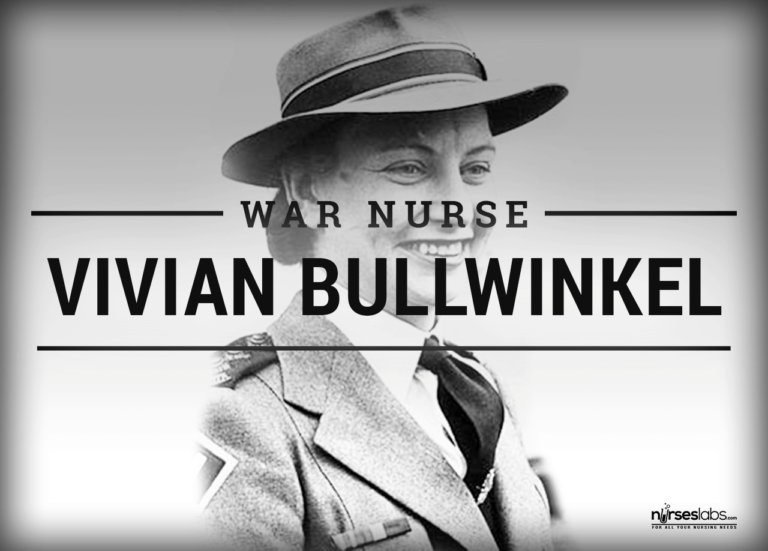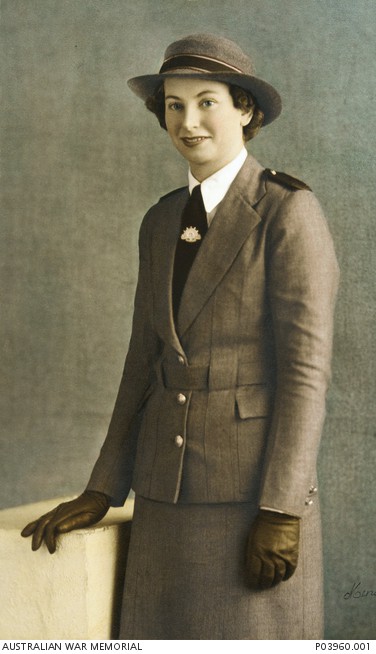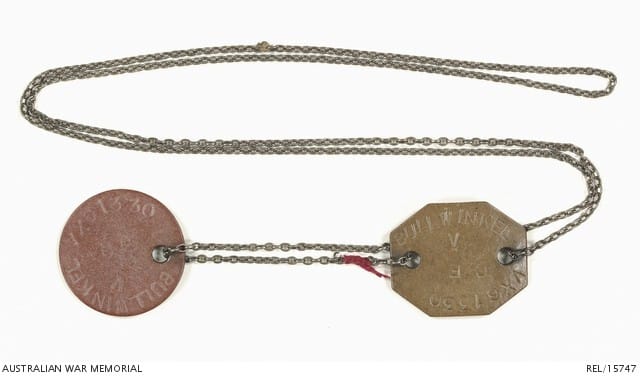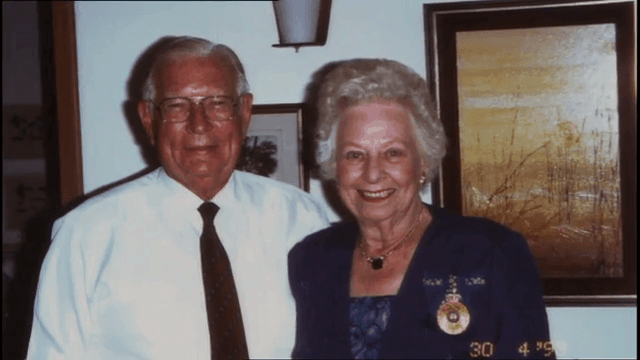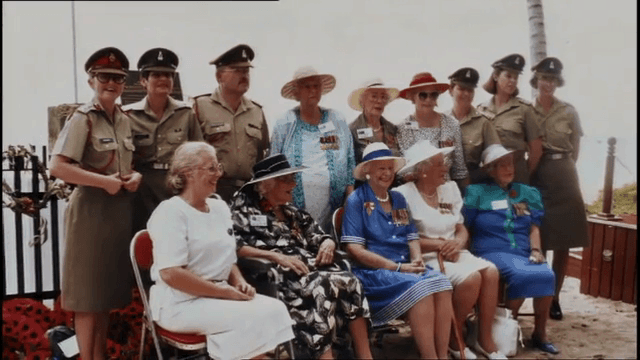How do you deal with life, especially during those times, when the good and the bad happened to you all at the same time?
For Australian nurse Sister Vivian Bullwinkel, it was a matter of following her primal instinct of survival and bravery when everything suddenly hits the fan.
The story of Vivian Bullwinkel was a story that got lost over time, but it is equally necessary to remember her history, nonetheless. She was well-known as the sole survivor of the Bangka Island Massacre that happened on February 16, 1942 on the Radji Beach of Bangka Island (Indonesia) during the heat of World War II. Out of the 22 nurses held captive on the shores of Bangka Island, she was the only one who made it out alive. It was a good thing she survived, but it was also a bad thing that she was the only one who survived.
Her dedication in trying to save the civilians under her care at the time of war would be her shining legacy until the end, despite having her head already an inch closer to the stake. And this is her tale.
The Nurse with Flat Feet
Born in Kapunda, South Australia in 1915, Vivian Bullwinkel trained as a nurse in Broken Hill, a town where her father worked as a miner in one of the mining companies. In 1938, she completed her general training at the Broken Hill and District Hospital, and completed Midwifery in 1939. She continued to work as a staff nurse at the Kiaora Private Hospital in Hamilton, Victoria, later on transferred to Jessie McPherson Hospital in Melbourne from 1940 to 1941. In here, she met Wilma Oram, a nurse who would be her long term friend in the coming years during and after the war.
Vivian initially applied as a nurse with the Royal Australian Air Force (RAAF), but unluckily failed the medical examination because of a silly reason: she had flat feet. But this rejection did not cause Vivian’s spirit to waver. She held on to the pursuit of putting her life on the line.
Together with Wilma, they signed up to work as volunteers in the Australian Army Nursing Service (AANS), and was accepted in 1941 as members of the neophyte group, the 13th Australian General Hospital (13th AGH).
That same year in the month of September, their unit sailed on the Hospital ship named Wanganella towards an unfamiliar territory. This territory would eventually become known as Singapore in the coming years.
Life in Singapore
In the first few weeks upon their arrival, the nurses started to miss home. Singapore was far from their home, and tracing back the steps back would mean a sign of weakness and having cold feet.
Vivian and the nurses spent their days doing medical and elective surgical cases, noting that the equipments were underprivileged and the conditions of the hospital’s environment poor. But despite the insufficient supplies and living in fear of the unknown, she still had the time to socialize with the nurses and the soldiers working with her unit, grabbing a few drinks and dancing with men at night. Writing in her diary became her little bit of blue sky, and every bit of experience that she had was diligently noted in.
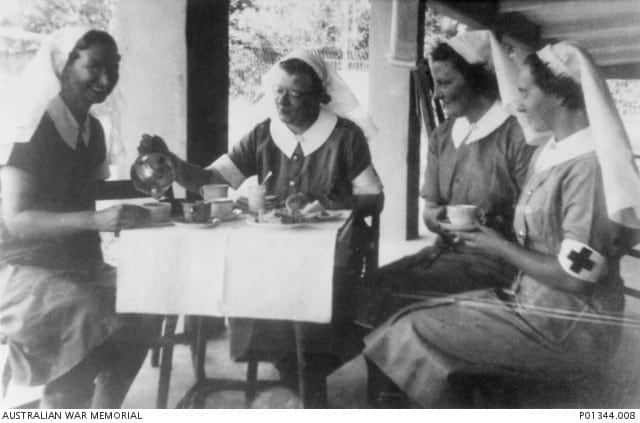
At this rate, Vivian and her fellow nurses would think that this was not a scene of war, and it might seem like the extent of the war was just a matter of false advertising. They were actually having a pretty fair time in that country. But their assumptions would soon change abruptly in December of 1941.
Downfall of Singapore
On the same morning that Pearl Harbor was attacked on December 7, 1941, General Yamashita’s 25th Army started to invade Malaya. Some parts of Singapore were also bombed. The Japanese began to rise in strength and was surging like a raging fire down the Malaysian Peninsula towards the island of Singapore.
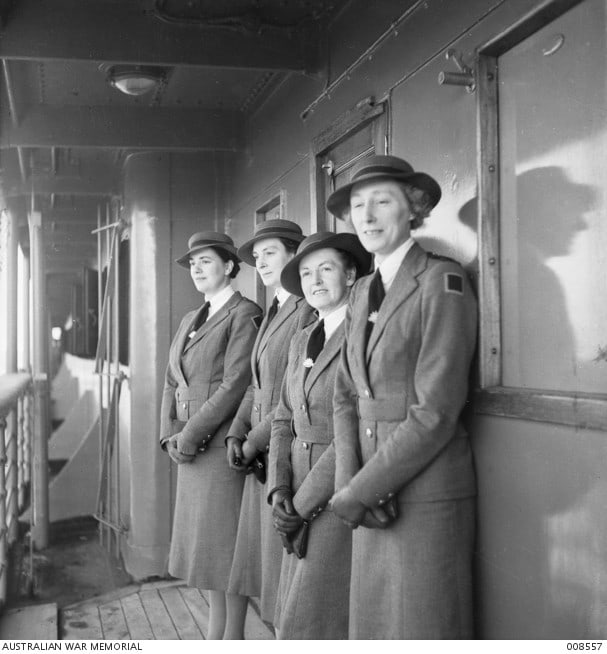
The nurses suddenly found themselves overwhelmed with too many wounded men and women to tend to. All of a sudden, Vivian saw with her own eyes the purpose as to why she signed up as a volunteer for the AGH. This is what they came for, and they are instantly losing touch from exhaustion due to working overtime. This is reality, and they have their hands finally full of it.
By the end of January 1942, the 13th AGH was forced to evacuate to another location, where they transformed St. Patrick’s School into a makeshift hospital in such haste. Bomb after bomb dropped within the vicinity, plus wounded patient’s streamed inside the facility nonstop. The nurses held fast in this kind of battlefield. It would be a matter of time before the next target would be where they are.
On February 8, 1942, Colonel A. P. Derham, the Assistant Director for Medical Services for the 8th Division, and Lt. Colonel Gly White had known that the moment to escape was now an immediate need. The nurses would be the top priority. Anyone who would not be able to make it would be left behind.
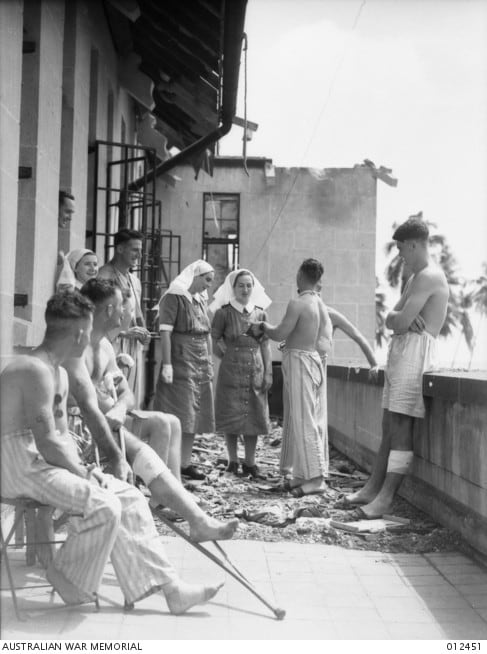
Two days after, in a heartbeat, the nurses were forced to get out of the facility at the last minute despite their persistent refusal to abandon their patients. They were tasked to bring as much casualties that they could carry aboard the nearest ship that they could find. Some were given only with one hour notice to pack what they could carry and run to the port where the ships were waiting. Time was ticking out. Emotions of guilt from leaving their patients behind and the fear for their lives are breaking their hearts into pieces. They were losing safe ground and the world around them was crashing down at their feet.
Emotions of guilt from leaving their patients behind and the fear for their lives are breaking their hearts into pieces.
With all the chaos of fighting for survival, Vivian, together with 64 other nurses, were finally able to get on board the SS Vyner Brooke on February 12 at 5:00 in the afternoon. There was no turning back. There was nothing to turn back to.
A Series of Unfortunate Events:
The Destruction of the SS Vyner Brooke
As the darkness loomed in, the SS Vyner Brooke started to set sail away from the hellish situation of Singapore. Just like in the movies, men, women, and children inside the Vyner Brooke looked on at the scene before them: the whole city was wrapped with violent fires, columns of smoke were covering the night sky, and the silence of forthcoming death gripped their hearts with fear.
The ship was originally built to carry only 12 passengers, but at that time, it managed to hold 265 passengers including Vivian and the nurses, all cramped and terrified of the gathering pandemonium in the city. The ship was also lacking supplies, food, and water. It was a suicide survival, but the risk was better than staying in the city that has already succumbed to the hands of the Japanese.
But the start of what could have been their escape was immediately riddled with bad luck. In the dark, the captain of the Vyner Brooke inadvertently directed the ship into a minefield, causing them to halt their progress and stay in the dark for hours until daybreak.
“Bullets from machine guns hailed from above puncturing lifeboats, body parts…”
February 13th, a Friday, the ship with its passengers spent the day hiding behind islands, trying to ward off any chance of being detected by the enemy via land, sea, and most importantly, by air. The captain knew that if they risk going out into the open sea, it would be too easy for the Japanese to locate them as the day was clear and sunny –perfect for flying scouts and drones and fighting jets. They were being hunted down, for sure. The captain could not take any chances.
So they continued their journey at night, making a successful trip, finally reaching the Bangka Strait, but not for long, as daytime eventually came. They were out in the dangerous open sea yet again. At around 2 pm of February 14, the ship started receiving attacks from above. They were panicking. An aerial attack was the last thing that they had hoped for. The moment that they had feared had arrived, and they were eventually detected.
Bullets from machine guns hailed from above puncturing lifeboats, body parts, and the body of the ship altogether in a symphony of chaos. Civilians were struggling and fighting to keep themselves alive, and if they could only walk on water, they would. But alas, the ship was destined to meet its end in these waters. There was no safe place to land.
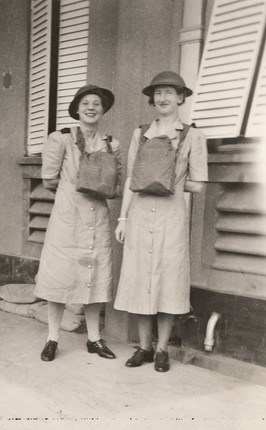
Bombs started to hit the funnel, the bridge, and the aft section of the ship. Like a paper boat, the ship began to sink within a matter of 15 minutes. Within the said 15 minutes, the civilians were badly injured and the nurses, including Vivian, has to give their best in saving as many casualties as possible, bringing them into the bullet-punctured lifeboats, abandoning the ship as this is of necessity.
Vivian recalled, “Those that weren’t keen to leave, we gave a helping hand to.” One lifeboat was said to have contained the children and the elderly. As they were lowered down, however, the Japanese planes started raining down peels of bullets to them, and the lifeboat turned over. Some of the civilians never made it out alive, as bullets started to rip them apart while they tried to swim towards somewhere safe.
True to her love for her profession, she ushered and protected the civilians without second thoughts, never rushing about saving herself first.
Vivian, after seeing that most of the civilians were already in the lifeboats, started to evacuate the sinking boat by climbing down the rope ladder. True to her love for her profession, she ushered and protected the civilians without second thoughts, never rushing about saving herself first. Hanging unto the side of one of the lifeboats with half of her body dipped in the water as it was already packed with civilians, they were able to reach the shores of Bangka Island by late afternoon, guided by a beacon of light coming from a bonfire that was already created by earlier survivors that made it to the shore.
Behind Enemy Lines: The Bangka Island Massacre
Exhausted, hungry, tormented with thirst, shaken with so many emotions from a series of trauma, and with no shelter from the cold, the survivors kept on arriving on the shores of Bangka Island all through the night. By morning, an approximate 60 survivors consisting of men, women, and children and 22 members of the AANS were huddled together on the Radji Beach.
A team of survivors, including Vivian and five other nurses, decided to scout the perimeter for available food and water. A small village was found but the castaways were never given a helping hand from the local villagers in the fear of the Japanese retaliation. They were advised to surrender themselves to the Japanese instead.
That night at the beach, they watched as another violent battle took place on the sea, lighting up the horizon with a deadly show of fire and destruction. Later, a large lifeboat brought a fresh wave of survivors, British servicemen, bringing the number of survivors to almost a hundred, huddled on the beach.
After much deliberation between themselves, it was decided to accept the advice of the villagers. Some of them were alarmed at the idea, and warned that it might be detrimental for all of them. A few felt scared after remembering what a soldier told them while they were still in Singapore, tending to his wounds. “The Japanese didn’t like taking in prisoners,” the soldier said.
“They’re not taking prisoners.”
“When the boys had come to the hospital [in Singapore] their one cry had been ‘they’re not taking prisoners.” Vivian warned, “It doesn’t matter what member of the forces came in. Their cry was the same: ‘they’re not taking prisoners.’ However, when you’re young and you’ve got a group of over 100 people, you can’t imagine anything happening to that. And every confidently felt that we would not be taken prisoners because of safety in numbers.”
But as the children became more agitated from starvation and fatigue for more than 48 hours, they decided to take the devil by the hindmost, and risk it. After all, what could go wrong? Thus they sent a small group of the civilians ahead of the pack in the hopes of finding the Japanese camps, and surrender in peace.
Matron Drummond, one of the senior nurses, suggested that everyone should start walking after the first batch to keep the children distracted from their hunger pains. The mothers, children and other civilian women started to press on, leaving behind Matron Drummond, the 21 nurses (Vivian included) tending to the injured, and an elderly woman who wished to stay with her injured husband. This decision by Matron Drummond would serve as their saving grace, buying them time away from the grave.
Sometime after they left the beach, Vivian noticed the arrival of the Japanese troops. They did not look like they are tripping for some prisoners as they immediately ordered half of the men to stand, and marched them at bayonet point down to a secluded part of the beach, out of their sight behind a headland. A few minutes after that, the Japanese returned and gathered the remaining men, and forced them to march the same path.
“Eventually the senior officers turn with a party of Japanese and he informed him…he was just brushed aside,” she said. “We just looked at each other and said ‘they’re not taking prisoners.’ And we seem to accept that fact.”
The nurses and the elderly woman were the only ones left on the beach. At the time, one of the nurses uttered a remark, saying “There are two things I hate the most, the sea and the Japs, now I’ve got them both!” The nurses laughed nervously, but their blood runs cold as rifle shots began firing at the direction where the men went to.
“There are two things I hate the most, the sea and the Japs, now I’ve got them both!”
The Japanese ominously returned, holding their rifles and bayonets that were dripping with fresh blood. They sat down in front of the women, cleaned their bayonets in silence, then motioned them to stand up once the cleaning of their weapons were done. The silence of the women were deafening, not one single whimper of fear was heard, all brave souls marching down the beach to meet their impending fate. It is time to face death. No one asked what to do, and no one made an attempt to run or fight. Fighting would be futile to be dared. They knew that the men were all dead.
The soldiers positioned all 22 nurses and the old woman to line up on the knee high surf, all facing the horizon in a straight line. The sound of their beating hearts, the wind brushing their faces, the nurses looked on the horizon, contented to face their end with no struggle or strife. No tears, no screams, no show of fear.
“Chin up, girls. I’m proud of you and I love you all.”
Matron Drummond then spoke, “Chin up, girls. I’m proud of you and I love you all.”
The Japanese then began to open fire from behind them in a cold blooded scene of murder, sparing no one.
“We were then ordered to march into the sea, we got out to almost waist-deep when they started shooting from behind,” Vivian recalled.
22. 21. 20. 19. Down to where she was standing, all the way to the person at the end of the line. One by one, in a single sweeping motion, the nurses fell on top of the other, like dominoes, lifeless and helpless as they disappear beneath the shallow waters, blood sprayed into the breeze and into the sea. An impact suddenly threw her face down into the waves. She was hit in the torso! As she floated, swallowing salt water in the process, she found that she was not yet dying.
“…they started shooting from behind.”
Wave upon wave of nausea pulsed through her because of the pain, but her instincts were calling her to hold it in, else fresh waves of bullets would be buried into her to finish her off. Feigning death, she was careful not to make a single movement, and held her breath for what felt like an eternity, sucking in minimal air as she could to survive, her heart beating faster for the fear of getting discovered that she was still alive. It was evident that there was no mercy in these twisted men as they walked up the beach and bayoneted who they deemed was still alive. The currents slowly washed her ashore. The world is still turning for Vivian after all.
“When I was hit I can remember thinking it’s like the kick in the mule and then I went down. I was very surprised to find myself still alive. I just laid there and eventually let the waves bring me in.”
After some time, as the night began to cover the horrors of the massacre on the shores, she took the courage to sit up as slowly as possible. She was alone on the beach. She tried to move, but another wave of nausea took over her as an excruciating pain swiftly shot out from her left hip, paralyzing her torso.
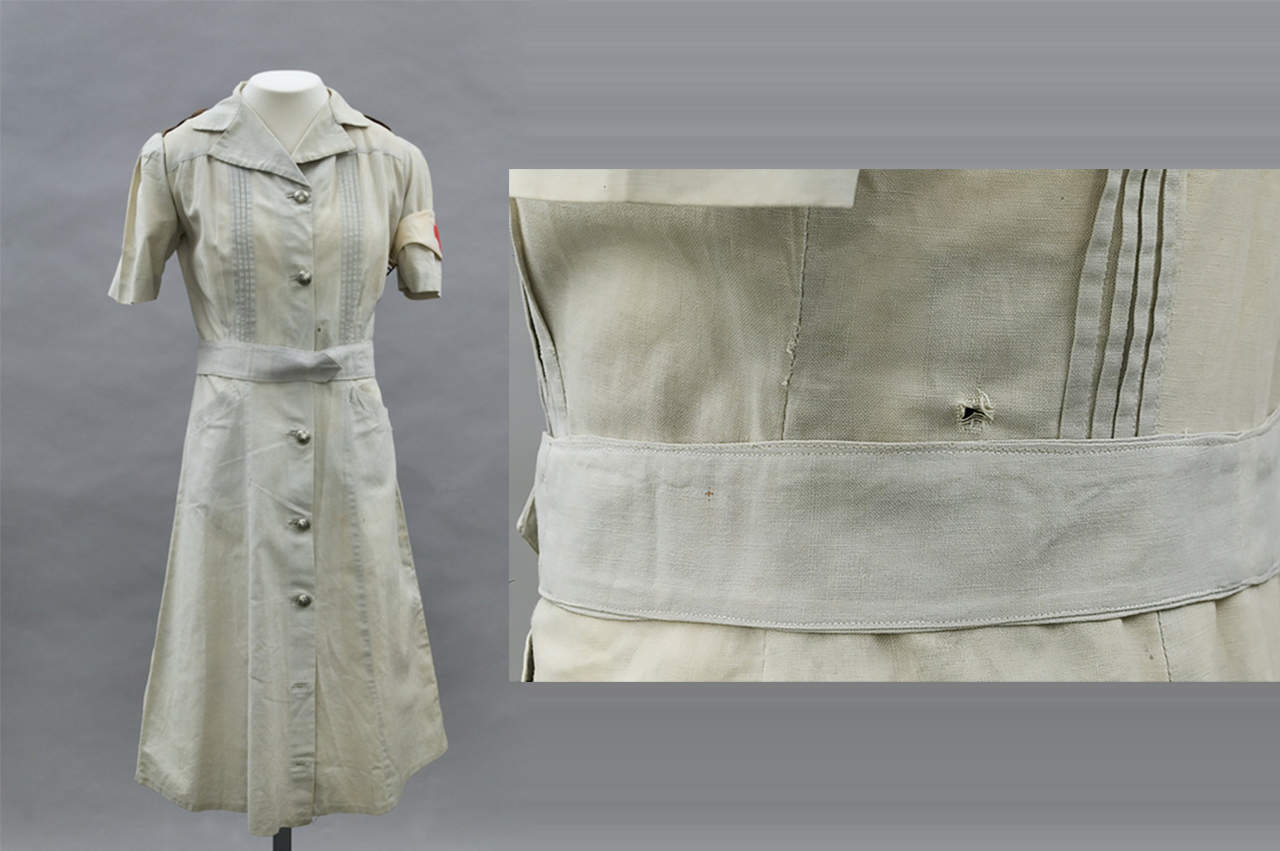
“The bullet that hit me struck me at the waistline and just went straight through,” she realized. She was badly wounded and bleeding, with a possibility that her vital organs were damaged by the bullet’s trajectory, but nevertheless, she was alive. “I looked around and there was no sign of anybody. There was nothing,” she later recalled. “Just me.”
Walking down a narrow path, staying clear out of the enemy, she crept away from the beach wading through the corpses and blood of her colleagues, her prime intention was to hide in the jungle. But after walking some twenty yards inside the forest, she was overcome with the need to lay down. “I don’t know whether I became unconscious or whether I slept,” she said. She slipped momentarily into the dark, and her world went black as she passed out.
She later came to, disoriented, parched, and with only one thing in her mind. The springs. She must have water. She tried to get up from her hiding place, but then halted as she spotted some ruthless Japanese walking on the beach at a distance. “My heart went to the bottom of the feet again,” she said. Like a deer in the headlights, she remained as still as she could, until she was sure that the Japanese had left. At that moment, she had another brush of death. The Japanese missed her yet again.
Fighting to Live
When the coast was clear, she rushed and abandoned her hideout, shaking as she made it to the springs. The water was like a ray of hope, and she greedily drank the spring water like it was going to run dry at any minute. All of a sudden, she heard a male voice behind her, saying, “Where have you been, nurse?”
“Where have you been, nurse?”
It was Private Pat Kingsley, a British soldier, who was also severely wounded, but had survived after being shot together with the men. Together, they kept each other concealed in the jungle and alive. Despite having her own wounds to mend, she made sure that Private Pat was given assistance, bringing what food she could gather from the local villagers. They remained hidden in the jungle for 12 days, until Vivian realized that they could not go on like that for a long time. Together with Private Kingsley, they decided that they would just give themselves up to the Japanese, and hope to be taken as prisoners yet again. A weak Kingsley agreed, but only with one condition in his mind. “I’ll be thirty nine tomorrow,” he mused, “And I’d like to think I had my thirty ninth birthday, free.” She responded with, “Time is no object,” and celebrated the next 24 hours in the jungle for his birthday and their last hours as free individuals.
Harsh Years of Incarceration
February 28, 1942. Vivian and Pat approached the Japanese camps, and were given entry to the prison walls. Vivian saw familiar faces. One of them was Wilma! Together with 30 other nurses, Wilma had unknowingly survived the sinking of the Vyner Brooke, something that Vivian never thought was possible.
Wilma would later remember Vivian’s arrival in the camp, saying, “When we first saw Vivian, we were overjoyed and hoped that there were more of our colleagues to come. Vivian was sunburnt, tired, and hungry. Her bloodstained uniform was taken from her and some of the blood washed out and, although clothes were not plentiful, Vivian was given something to wear to cover her wound. A little cooked rice was found and a small amount of water. A sleeping space was made for her on the sloping concrete slab, but we had no bedding.”
Curious as to what have happened, on and on, her colleagues kept asking Vivian about the other nurses but she kept mum about it. Recalling, she said: “I’ve made up my mind that I wasn’t going to say anything about any of these girls who were with me. ‘Coz these are the very people they keep asking because they’re are the ones who are still missing! And I said ‘No.’ and then in the end I said ‘Yes. I do know.’ And when I told them, they were absolutely appalled.”
Not a single person breathed a word about her as an eyewitness to the bloodbath that happened in the shores of Bangka beach. She had to hide her bullet-riddled nurse’s uniform and diary, made from bible pages. She would remain hidden, emerging later as a witness to one of the most violent war crimes committed against defenseless women on the siege of Singapore.
Not a single person breathed a word about her as an eyewitness to the bloodbath that happened in the shores of Bangka beach.
Shortly after her arrival in the camp, she found out that Pat had passed away. His wounds were terribly fatal, as he got hit with bullets in the abdomen, and his death was presumed to brought about by damaged organs and infection. Despite her best efforts, Vivian was not able to save him. In the end, she find solace in the thought that they had time together in the jungle, where they hoped, fought, and celebrated a few days with each other as free as they were alive. Pat’s death left Vivian the only survivor to tell the massacre in Radji Beach.
Vivian wanted to live because she wanted to tell her story. It would seem unfair that she was the only one who lived, but she later contested that it was God’s grace, for if she had not lived, how would the world know of the names of the bravest nurses there was. Without her, the people who she called her friends would be forgotten beneath the history books of war.
Treated like cattle more than human beings
Vivian remained a prisoner of war for three years and a half, where she survived beatings and vicious inflictions in the Sumatran prison walls. Treated like cattle more than human beings, they worked for hours and then paid with 80 cents a day for their trouble. They were constantly harassed by their captors and one example was when they would sometimes stand up in the sun without a hat on for 12 hours. She laboured cooking, nursing, and working on the hygiene and burial rites. They had to endure cleaning out the clogged toilet drains with the use of a coconut shell, then dumping the human wastes a half mile into the jungle in manual labour. The longest wait for the war to end was in their prayers every night, and they were hopeful that the brutality would soon end.
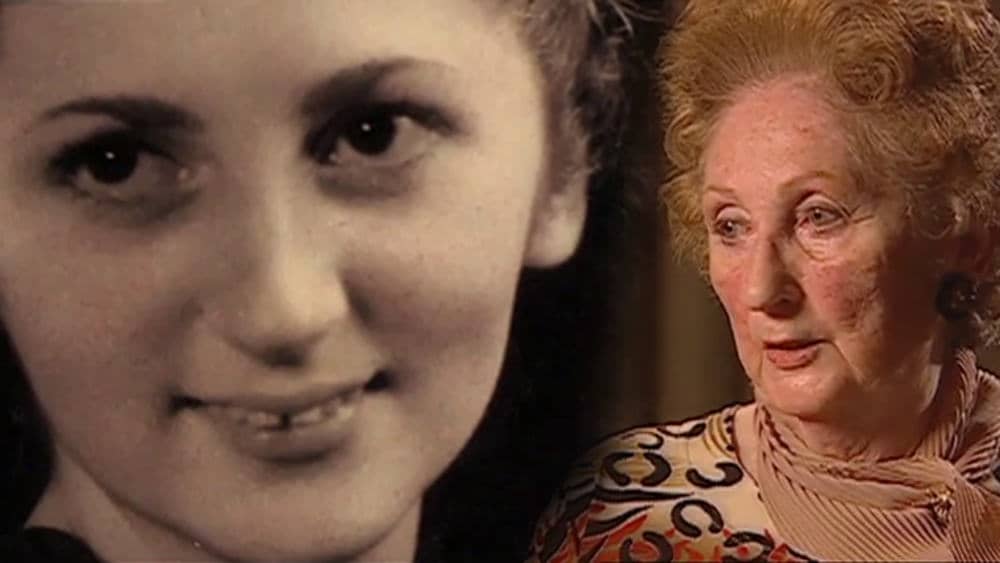
Former civilian prisoner of war Betty Kenneison (Edie Leembruggen), gave a glimpse of what harsh life they had in the camp was like: “Imagine what it’s like not to have a toothbrush, a comb, no shoes, tattered clothes, [body] so thin that you could put your fingers around your upper arm. Food that is thrown at us rotting food, putrid meat our feet are covered in mud, and the monsoons come awashed with feces.”
Nursing Against All Odds
Despite being prisoners of war, Vivian together with the other nurses made it a point to make life as comfortable as possible for their fellow captives. Lacking medical supplies the nurses did not forget their grand duty to care for the sick whilst having nothing.
“We had nothing, literally nothing to care for our patients with,” Vivian recalls. “The hospital [was] just a hut, roof-leaf, earthen floor and bamboo and bench on a side. No mattresses or linen, or anything like that. Nothing.”
Their remarkable resourcefulness as a nurse exemplified as they made use of what they have, “Now we did pound the embers of the fires into a powder which we gave to our patients, that’s supposed to be literally good for diarrhea but our patients all had dysentery by this time.”
Betty recalls the time when Vivian saved her life, “I was being attended to by my step grandmother and she had boiling water in a cloth which she applied to my head. The flies had laid maggots in my head and she was trying to kill them. I was screaming and shouting with pain. And the door opened and Vivian walked and went up to my nan and she said to her, I will attend to this girl in the future. My nan was not pleased. But actually, Viv’s intervention was a blessing in disguise because it was the maggots that cleared up the pus in my head.”
There, Betty found a hero on Vivian. “Viv always looked out for me. She would say, I want you to see me everyday and report to me and let me know what you’re doing. She was very caring. She made me her responsibility in a way.”
Vivian was the light among many POWs, with her friend Wilma saying, “Vivian was a stalwart in the camp and everybody admired her for what she did.” Vivian’s friendship helped her survive three and half years as a POW.
Three and a half years of starvation and torture took toll in Vivian and her colleagues. Over the next few months, Vivian lost eight of her colleagues that even through the face of death, the nurses are still caring for others and would apologize for wasting valuable resources for taking too long to die.
even through the face of death, the nurses…would apologize for wasting valuable resources for taking too long to die
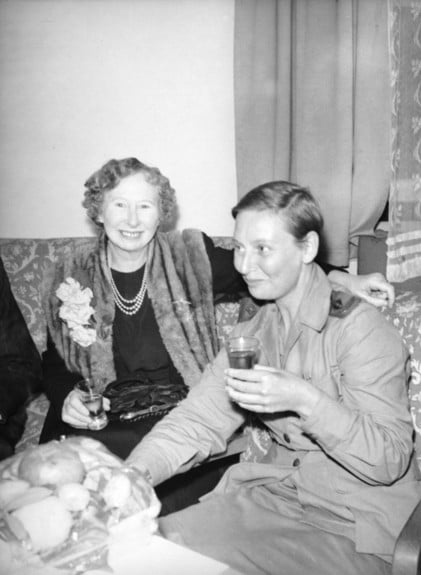
In 1945, the war ended. The original 65 nurses who boarded the SS Vyner Brooke were reduced to 24 survivors. Australia’s army senior nurse Col. Annie Sage personally joined the rescue and evacuation of her missing nurses. She flew to the prison camp and opened the plane’s door expecting to see 65 nurses, saying “I am the mother of you all, where are the rest of you?” To her dismay, she only saw 24 survivors. Returning to the Australian shores after peace was declared post World war II. It was believed that 12 nurses drowned during the sinking of the ship, 21 nurses massacred on the Radji beach, and eight of them perished as prisoners of war in the camps.
Taking pride on being members of the Australian Army Nursing Service, the remaining 24 nurses saved up their uniforms during their captivity. Their code of honor is so admirable that they insisted to be seen publicly again wearing the same uniforms despite being tattered with bullet holes or tainted with dirt.
Stepping down of the plane in Singapore to a sea of journalists, the nurses dressed in their uniforms with emaciated bodies and worn condition, in a sense, were enough to give the press the hell that they’ve been through.
The nurses dressed in their uniforms, stepped down of the plane in Singapore to a sea of journalists. With their emaciated bodies and worn condition, in a sense, gave an idea to the press the hell that they’ve been through.
Vivian stood up and says “I want you to hear this story, because I don’t want anybody to believe that the Japanese are not as black as they have been painted, because they are.” That is the time when Vivian narrated the horrific incident in Bangka Island.
And of the daily news people heard on the atrocities of the Japanese, they were extremely appalled by what the soldiers did to the defenseless nurses. Her story was so sensational that when injured Australian soldiers hospitalized in Singapore heard of it from the radio, they became hysterical and angry that wanted to shoot the Japanese soldiers in the head. In a similar manner, an Australian army sergeant wept in shame as he saw the wasted nurses get off the plane in great regret that the men should have protected the women.
Newspapers were fixated on Vivian’s remarkable story of survival but as far as possible Vivian avoided the limelight and insisted that her story was of little significance when compared to the bravery of her fallen friends. Instead, she concentrated on spending time with and writing to the families of those who would not return home.
Calm After the War: Vivian’s Legacy
Together with Wilma, they worked together at the Heidelberg Military Hospital in Australia until June of 1946. It would seem that their experience with the rage of war would make them hide behind safe walls, but it never wavered their courage and need to serve the people. With their POW colleagues, they travelled to all parts of Australia, helping those who needed care and medical treatment.
In 1946, Vivian gave evidence to the Tokyo War Crimes Tribunal in Tokyo where she relieved her horrifying experiences on Radji beach. The tribunal congratulated her on the courage she showed in testifying which resulted in 26 Japanese soldiers being tried. But the Japanese commander accused of ordering the massacre escaped justice by committing suicide in his cell.
Vivian found going to Japan difficult, after three and half years as a prisoner of war, and losing many of her colleagues to the Japanese, she felt forgiveness was beyond her. But after visiting the devastated city of Hiroshima, she couldn’t fail to be moved by the suffering of the Japanese people.
She then retired after December 1947 from the AANS, and returned to become a civilian nurse. She was also loved dearly as a Director of Nursing at the Fairfield Hospital in Melbourne.

In a later period of her life, Vivian and Betty Jeffrey, one of the POW survivors, took a fundraising tour all across Victoria in the hopes to gain enough funds to build a memorial for the fallen nurses at the time of the war, and their efforts paid off. Unbelievably, they were able to raise 240,000 pounds.
The Nurses Memorial Centre was also launched as a place for the welfare and development of the nursing profession, where Vivian left her legacy, her mark in the bequest of Australian nurses. She remained a patron to the memory of her fallen colleagues, going to philanthropic activities, and serving the veterans in honor of those who sacrificed so much for peace.
She later became a council member, then progressed to becoming the President of the College of Nursing in Australia (later known as the Royal College of Nursing, Australia). She worked tirelessly in establishing a movement of the Australian nursing education from the hospital to the University division. This had become a catalyst in improving the nursing education curriculum, as well as improved the employment grade of the nurses, bringing forth an upgrade in the salary scheme and working conditions of the Victorian nurses.
Working to pay her gratitude to the people of Malaysia for helping her at the time of her needs, she supported a scholarship fund for the Malaysian nurses to pursue a postgraduate study in Australia. She then became the patron of the National Service Nurses’ Memorial. In October 1999, in a joint affair to commemorate 100 years of military nursing, she became a guest of honor in dedicating this memorial in Canberra. This memorial is still located alongside other military memorials in Anzac Parade.
Remembering the Fallen
In a moving chapter fifty years after the Bangka Island massacre, in 1993 she returned to the island, to pay honor to the ones who were forgotten by time, but had equally sacrificed so much without receiving any mercy.
“Why me?”
After all, what kind of heart would she be if she doesn’t look back to the place that gave more meaning and hope to her life? Recalling the question she had in mind she said, “At that time, I ask ‘Why me? Why me?’ And then this time went on — I still say, ‘Why me?'” She walked the sandy shore, trying to spark an emotion from the past, but the horrors of the island seemed to have transformed into a mere nightmare that she had now forgotten. She was healed, with time. The island had buried and transformed that memory into a secret, never to be found again by anyone.
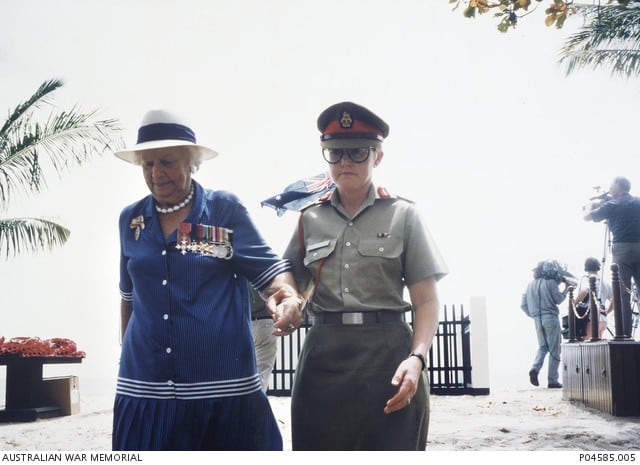
She visited the fresh water springs, remembered Private Pat Kingsley in it, walked into one of the POW camps, and visited the grave sites, but she was unable to locate the exact beach that almost washed her life away. It was as if she forgot that she was an active participant of the massacre, and her memories of terror were overruled by the goodness of the life that she had after the war. Nothing evil can really darken the heart, no matter how haunting and poisonous the past was.
Before she left the island, together with some of her POW colleagues, they picked a spot where they thought was almost similar to the location of the massacre, and revealed a shrine as a tribute to the 41 nurses who lost their lives, so that they could move on and live.
The Contributions of the Nurses at War Often Go Unrecognized
One of the nation’s greatest resource during war are the medical corps that aids the wounded soldiers during battle. At that time, the patriotism had spurred the citizens like Vivian to engage in situations that required them to risk their own lives for the sake of the greater good. They already knew that it was a solitary suicide to sign up for the war. Still, Vivian, along with many civilians and nurses at that time, volunteered themselves anyway.
But whenever the new age talk about history, oftentimes, the names of these nurses were no longer put into reference. Most of their stories of bravery against fascism were forgotten and never published.
Being a nurse of war is often a distinction that was rarely made from the ones that were working in the hospitals, but nevertheless, they are the nurses that deserved all the recognition there is. To say the least, signing up for battle would mean getting behind enemy lines, and be dead without rhyme or reason, just because, you are part of the opposing team.
The wartime dedication of the nurses during World War II was impressive in the sense that most of these nurses have no experience with warfare, yet they worked with soldiers with commitment.
People also failed to realize that the minute the nurses and the medical team got captured, the battalion is equally handicapped. As resolute as an army may seem, the presence of unyielding nurses would became the backbone of the army, holding the soldiers straight for them to survive.
War is ugly and exhausting
War is a sin that we try to glorify by saying that these men and women have brave hearts that are fighting for a good cause, for the wellbeing of everyone. But take off all the sugar coats, and the real face of war will always remain unappealing.
Nurses in these situations face the horrors of war, a horror so wild it destroys the nurses state of mind. It is often believed that the medical team usually goes unharmed during war as the enemy could use them as back up medical aid for their wounded soldiers. But the story of Vivian proved that nurses are also required to pay the ultimate price.
What is in exchange for signing up?
Nurses took the opportunity to be in the corps perhaps to take advantage of the provisions doled out to anyone who would want to work at the front lines of war. These provisions would include free education, a competitive salary, and an appetizing retirement scheme. But upon signing up, these nurses knew that they are now pressured to try to make it out alive. There is still that uneasy feeling of impending doom. In the end, wars are sickening, the environment harsh, it is terribly abhorrent, and unkind in totality. It makes us think was it really worth it in the end?
The many faces of these anonymous nurses who went headfirst into the unknown remained mere echoes in the dreadful battlegrounds, and their deaths highlighted their purpose of serving the world for peace. There are still many of these nurses out there who are going to be like Vivian, seduced to join the army, all because fighting for a good cause gives them a sense of fulfilment as a person.
References and External Links
